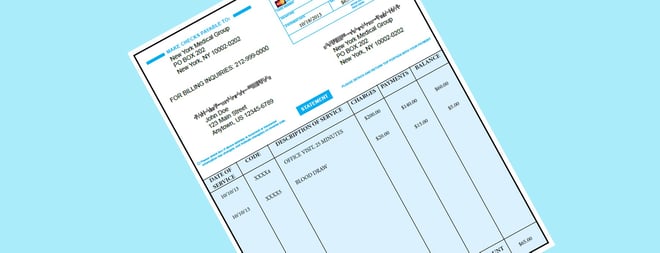 I recently received a medical bill in the mail (actually, a few of them!). While this may not seem like a cosmic event, it was a new experience for me, having recently gotten out of the military. For all of my adult life thus far, I hadn’t had much experience with having to pay medical bills out of pocket since everything was taken care of within the larger government healthcare system. Because of this new learning experience, I’m uniquely qualified to write on ways that private practices can improve patient collections...simply by altering their medical billing statements. Here are some things I noticed that could be improved, as well as some good practices already in place…
I recently received a medical bill in the mail (actually, a few of them!). While this may not seem like a cosmic event, it was a new experience for me, having recently gotten out of the military. For all of my adult life thus far, I hadn’t had much experience with having to pay medical bills out of pocket since everything was taken care of within the larger government healthcare system. Because of this new learning experience, I’m uniquely qualified to write on ways that private practices can improve patient collections...simply by altering their medical billing statements. Here are some things I noticed that could be improved, as well as some good practices already in place…
What did they get right on their medical billing statement?
- It was very clear how much was owed by the patient (me). This was helpful because the cost of the visit and procedure were also on the bill, as well as the amount covered by my insurance provider. The layout of this particular bill made it clear what had already been paid, and what we still owed.
- The second technique that was very useful is that there was an option to pay the required amount right on the bill itself. As you can see from the picture below, it was very easy to pull out a credit card, fill in the required boxes, and mail the slip back. This was much easier than finding a checkbook and figuring out who to make it out to...in fact, that information was in a completely different part of the bill and was somewhat hard to find. Good thing I didn’t plan on writing a check anyway!

What could be improved on the medical billing statement?
- The most glaring omission from both bills I received lately was the absence of a due date for payment. One bill only had a “statement date,” and no mention of when payment was due at all. The other medical billing statement said “PLEASE PAY WITHIN 15 DAYS OF RECEIPT” down at the bottom. But that is rather ambiguous...how do they know when I’ve received the bill in the mail? Does it need to arrive 15 days later or be postmarked no later than 15 days after receipt? And if I am late, does that mean the account is going to collections? What if it gets lost in the mail? All of these are perfectly legitimate questions, and it is a simple fix to include this information on a medical billing statement. A note for private medical practices: set an explicit due date, and notify the patient if this is the first, second, final, etc bill.
- A second addition to medical billing statements that would be helpful is to have procedures and providers spelled out in the “description” section. Consider if you’ve had many visits to the doctor lately, or you have a large family and multiple people have been seen, or it’s been awhile between the visit and receiving the bill in the mail. It’s hard to confirm what you’re being charged for, especially when the description is “office/outpatient visit.” Keeping HIPAA requirements in mind, it would greatly benefit patients (and help their memory) if the line-item description section was a little more...descriptive.
So there you have it - suggestions to improve patient collections from the perspective of patients themselves! What other tips would you suggest?



